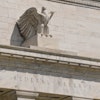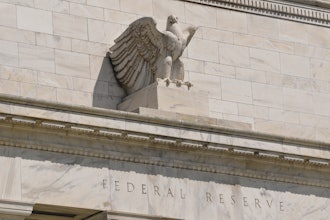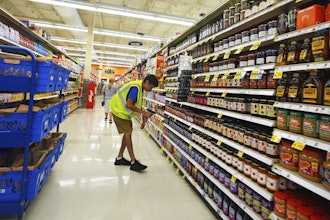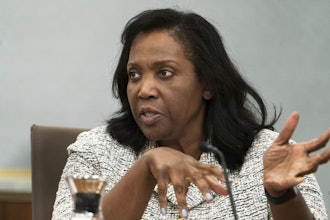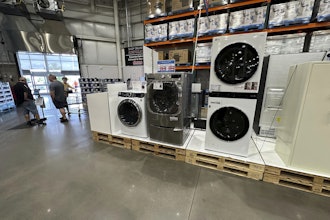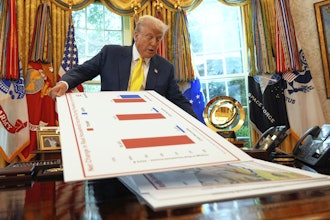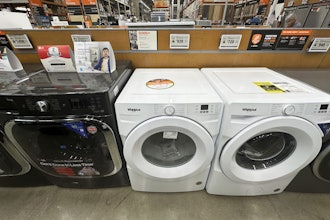
WASHINGTON (AP) — Inflation surged in June and workers' average wages accelerated in the spring — signs that Americans won't likely feel any relief from rising prices anytime soon and that the Federal Reserve will feel compelled to further raise borrowing costs.
An inflation gauge closely tracked by the Fed jumped 6.8% in June from a year ago, the government said Friday, the biggest such jump in four decades. Much of the increase was driven by energy and food.
On a month-to-month basis, too, prices surged 1% in June, the biggest such rise since 2005. Even excluding the volatile food and energy categories, prices climbed 0.6% from May to June.
Employees’ wages, excluding government workers, jumped 1.6% in the April-June quarter, matching a record high reached last fall. Higher wages tend to fuel inflation if companies pass their higher labor costs on to their customers, as they often do.
Friday’s figures underscored the persistence of the inflation that is eroding Americans’ purchasing power, dimming their confidence in the economy and threatening Democrats in Congress in the run-up to the November midterm elections.
Some signs indicate that certain categories of inflation may moderate in the coming months, though not by very much: Gas prices have fallen since mid-June from an average national peak of $5 to $4.26, according to AAA. Likewise, other commodity prices, for items such as wheat and copper, have plunged.
But more persistent drivers of inflation show little, if any, evidence of slowing. The wage data released Friday — a measure known as the employment cost index — indicated that paychecks were still growing at a robust pace. That's good for workers, but it could raise concerns at the Fed about its effect on prices. Chair Jerome Powell specifically cited this measure during a news conference Wednesday as a source of concern for the the central bank's policymakers.
“This is a (report) that’s going to keep Fed officials up at night,” said Omair Sharif, president of Inflation Insights.
The government also reported Friday that consumer spending managed to just outpace inflation last month, rising 0.1% from May to June. Spending actually jumped, but most of the gain was wiped out by higher prices.
Rising consumer demand for services, such as airline tickets, hotel rooms and restaurant meals, is still helping fuel inflation. Many retail and consumer goods chains, though, say inflation is squeezing shoppers and limiting how far their money goes — a sign that consumer spending could further weaken.
This week, Walmart said its profits would fall because its customers are spending more on pricier food and gas, leaving them less able to buy clothes and other discretionary items. Likewise, Best Buy downgraded its sales and profit forecasts because surging inflation has forced consumers to reduce their purchases of electronics appliances.
Inflation has been rising so fast that despite the pay raises many workers have received, most consumers are falling behind the rising cost-of-living.
High inflation and interest rates are also hampering the U.S. economy, which shrank in the April-June quarter for a second straight quarter, intensifying fears that a recession is looming. Two quarters of declining growth meet an informal rule of thumb for when a recession begins, although robust hiring suggests that the economy still maintains pockets of strength and isn't yet in a downturn.
On Wednesday, the Fed raised its benchmark interest rate by three-quarters of a point for a second straight time in its most aggressive drive in more than three decades to tame high inflation. Powell signaled that the Fed’ could raise rates by smaller increments in the coming months.
Still, he also stressed that the Fed’s policymakers regard the fight against inflation to be their top priority. He gave no hint that a weakening economy would cause the Fed to slow or reverse its rate hikes this year or early next year if inflation remained high.
By raising borrowing rates, the Fed makes it costlier to take out a mortgage or an auto or business loan. The goal is for consumers and businesses to borrow, spend and hire less, thereby cooling the economy and slowing inflation.
Globally, inflation is weighing heavily on other economies, too. This month, prices jumped 8.9% in the 19 European countries that use the euro currency from a year earlier. Europe's economy has been hit particularly hard by higher natural gas and oil prices stemming from Russia's invasion of Ukraine, though it managed to grow slightly in the second quarter.
The Fed monitors Friday’s inflation gauge, called the personal consumption expenditures price index, even more closely it does the government’s better-known consumer price index. Earlier this month, the CPI reported an acceleration in inflation, to 9.1% in June from a year earlie r, the highest in nearly 41 years.
The PCE index tends to show a lower inflation level than CPI. Rents, which are rising at their fastest pace in 35 years, are given less weight in the PCE than in the CPI.
The PCE price index also seeks to account for changes in how people shop when inflation jumps. As a result, it can capture, for example, when consumers switch from pricey national brands to cheaper store brands.


